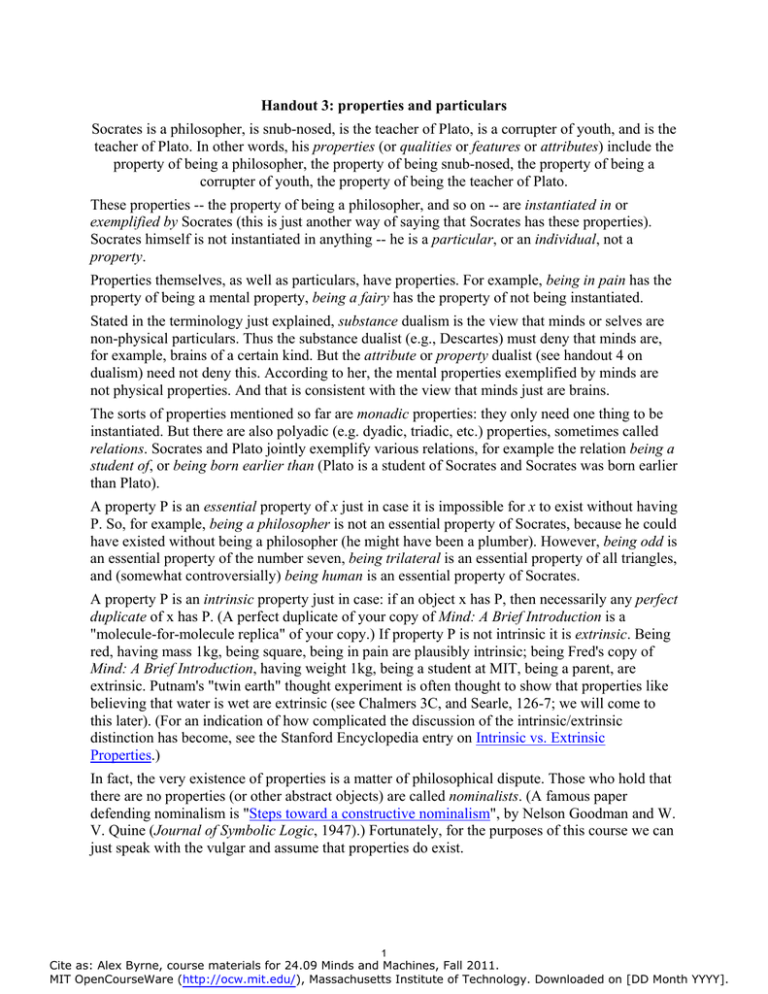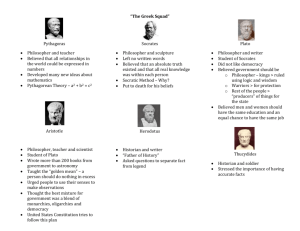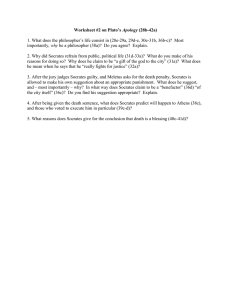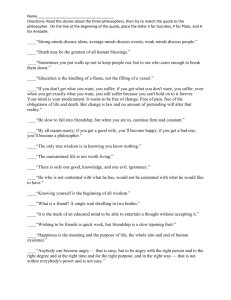Handout 3: properties and particulars
advertisement

Handout 3: properties and particulars Socrates is a philosopher, is snub-nosed, is the teacher of Plato, is a corrupter of youth, and is the teacher of Plato. In other words, his properties (or qualities or features or attributes) include the property of being a philosopher, the property of being snub-nosed, the property of being a corrupter of youth, the property of being the teacher of Plato. These properties -- the property of being a philosopher, and so on -- are instantiated in or exemplified by Socrates (this is just another way of saying that Socrates has these properties). Socrates himself is not instantiated in anything -- he is a particular, or an individual, not a property. Properties themselves, as well as particulars, have properties. For example, being in pain has the property of being a mental property, being a fairy has the property of not being instantiated. Stated in the terminology just explained, substance dualism is the view that minds or selves are non-physical particulars. Thus the substance dualist (e.g., Descartes) must deny that minds are, for example, brains of a certain kind. But the attribute or property dualist (see handout 4 on dualism) need not deny this. According to her, the mental properties exemplified by minds are not physical properties. And that is consistent with the view that minds just are brains. The sorts of properties mentioned so far are monadic properties: they only need one thing to be instantiated. But there are also polyadic (e.g. dyadic, triadic, etc.) properties, sometimes called relations. Socrates and Plato jointly exemplify various relations, for example the relation being a student of, or being born earlier than (Plato is a student of Socrates and Socrates was born earlier than Plato). A property P is an essential property of x just in case it is impossible for x to exist without having P. So, for example, being a philosopher is not an essential property of Socrates, because he could have existed without being a philosopher (he might have been a plumber). However, being odd is an essential property of the number seven, being trilateral is an essential property of all triangles, and (somewhat controversially) being human is an essential property of Socrates. A property P is an intrinsic property just in case: if an object x has P, then necessarily any perfect duplicate of x has P. (A perfect duplicate of your copy of Mind: A Brief Introduction is a "molecule-for-molecule replica" of your copy.) If property P is not intrinsic it is extrinsic. Being red, having mass 1kg, being square, being in pain are plausibly intrinsic; being Fred's copy of Mind: A Brief Introduction, having weight 1kg, being a student at MIT, being a parent, are extrinsic. Putnam's "twin earth" thought experiment is often thought to show that properties like believing that water is wet are extrinsic (see Chalmers 3C, and Searle, 126-7; we will come to this later). (For an indication of how complicated the discussion of the intrinsic/extrinsic distinction has become, see the Stanford Encyclopedia entry on Intrinsic vs. Extrinsic Properties.) In fact, the very existence of properties is a matter of philosophical dispute. Those who hold that there are no properties (or other abstract objects) are called nominalists. (A famous paper defending nominalism is "Steps toward a constructive nominalism", by Nelson Goodman and W. V. Quine (Journal of Symbolic Logic, 1947).) Fortunately, for the purposes of this course we can just speak with the vulgar and assume that properties do exist. 1 Cite as: Alex Byrne, course materials for 24.09 Minds and Machines, Fall 2011. MIT OpenCourseWare (http://ocw.mit.edu/), Massachusetts Institute of Technology. Downloaded on [DD Month YYYY]. MIT OpenCourseWare http://ocw.mit.edu 24.09 Minds and Machines Fall 2011 For information about citing these materials or our Terms of Use, visit: http://ocw.mit.edu/terms.


